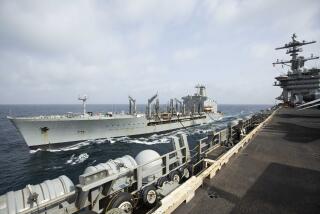SPILL AT A GLANCE
- Share via
THE SPILL Ship: American Trader Oil spilled: Estimated 300,000 gallons, Southern California’s biggest in two decades When: About 4:30 p.m. Wednesday Where: About two miles off Huntington Beach at Golden West Offshore moorings Ocean depth: About 60 feet, sandy bottom How: Ship owners suspect the American Trader ran over its anchor as it rode the swells, piercing a three-foot hole in the bottom of the hull in the bow. A starboard “wing tank” ruptured, spilling oil. The slick: More than four miles long and two miles wide Oil left: Damaged tank still three-quarters full, but that oil remains inside because of fluid dynamics--the tank’s oil level has sunk just far enough to match the level of the water outside the ship’s hull. THE SHIP Built: In 1969 by Sun Shipbuilders and Drydock Inc. of Philadelphia, now defunct. Named America Sun. Acquired by American Trading Transport Co. Inc. on July 11, 1989, and renamed American Trader. Chartered by British Petroleum Co. of North America, which was chartering it at the time of the spill. Width: 125 feet Length: 800 feet Hull depth: 42 feet Anchor: About 10 feet long Oil capacity: 23 million gallons. Was fully loaded at time of spill. Itinerary: Planned to unload more than 12 million gallons at the sea berth, where a pipeline connects to a Santa Fe Springs refinery. The rest was to be delivered to the Port of Long Beach. THE CLEANUP Offshore: Several sweepers dispatched, sucking up the oil. Coast Guard also on the scene to monitor operation. Beaches: Beaches should prove easier to clean than rocky shores of Prince William Sound, site of catastrophic Exxon Valdez spill last year. Rocks there had to be scrubbed. Along Orange County coast, workers can dig up the oil-soaked sand and cart it off. Preventive measures: Rubberized booms set up to keep oil away from estuaries at Bolsa Chica wetlands and Upper Newport Bay. Environmentalists worried about a potential disaster for birds if oil seeps past the barricades. Options: Officials have, for now, ruled out chemical dispersants, which break up slick into small droplets. Can reduce the chance that oil will wash ashore, but cannot be used in shallow areas because of possible toxic effects on bottom-dwelling organisms, fish or shellfish. Calm water conditions Thursday also ruled out dispersants, which work best with churning wave action that mixes them into the oil. Birds: 25 oil-covered sea gulls, grebes, cormorants and scoters washed ashore after the spill, eight of them dead. If slick reaches Bolsa Chica wetlands at north end of Huntington Beach, it would be devastating to one of California’s largest ecological reserves. California brown pelican, California least tern, the light-footed clapper rail, and the salt marsh bird’s beak, an upper marsh coastal plant, are endangered species in the wetlands. Other wildlife: Expected to take a deadly toll on fish and perhaps marine mammals such as sea lions. Oil mats their fur, making them susceptible to cold and less buoyant. More critically endangered may be tiny links in aquatic food chain--anchovies, mussels and barnacles. Sources: Coast Guard and Times staff
More to Read
Sign up for Essential California
The most important California stories and recommendations in your inbox every morning.
You may occasionally receive promotional content from the Los Angeles Times.












![Vista, California-Apri 2, 2025-Hours after undergoing dental surgery a 9-year-old girl was found unresponsive in her home, officials are investigating what caused her death. On March 18, Silvanna Moreno was placed under anesthesia for a dental surgery at Dreamtime Dentistry, a dental facility that "strive[s] to be the premier office for sedation dentistry in Vitsa, CA. (Google Maps)](https://ca-times.brightspotcdn.com/dims4/default/07a58b2/2147483647/strip/true/crop/2016x1344+29+0/resize/840x560!/quality/75/?url=https%3A%2F%2Fcalifornia-times-brightspot.s3.amazonaws.com%2F78%2Ffd%2F9bbf9b62489fa209f9c67df2e472%2Fla-me-dreamtime-dentist-01.jpg)